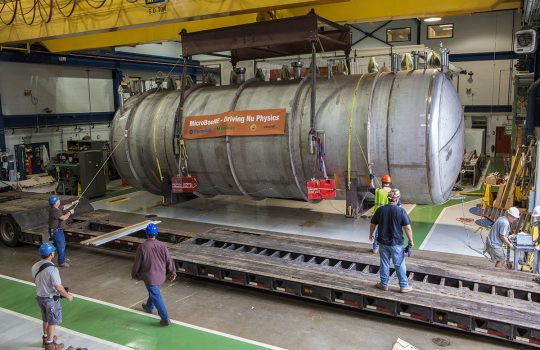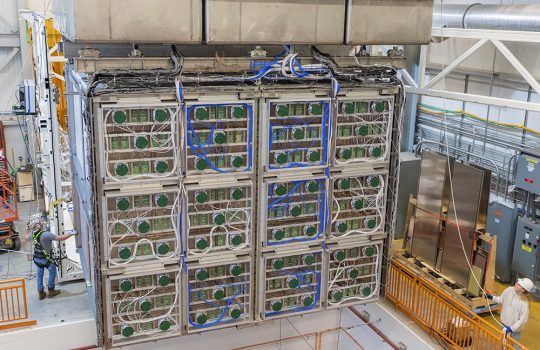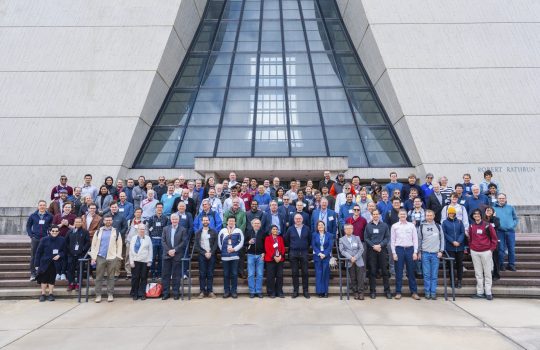Batavia IL — Physicists at the Department of Energy’s Fermi National Accelerator Laboratory today (March 2) announced the discovery of the subatomic particle called the top quark, the last undiscovered quark of the six predicted by current scientific theory. Scientists worldwide had sought the top quark since the discovery of the bottom quark at Fermilab in 1977. The discovery provides strong support for the quark theory of the structure of matter.
Two research papers, submitted in Friday, February 24, to Physical Review Letters by the CDF and DZero experiment collaborations respectively, describe the observation of top quarks produced in high-energy collisions between protons and antiprotons, their antimatter counterparts. The two experiments operate simultaneously using particle beams from Fermilab’s Tevatron, the world’s highest-energy particle accelerator. The collaborations, each with about 450 members, presented their results at seminars held at Fermilab in March 2.
“Last April, CDF announced the first direct experimental evidence for the top quark,” said William Carithers, Jr., cospokesman, with Giorgio Bellettini, for the CDF experiment, “but at that time we stopped short of claiming a discovery. Now, the analysis of about three times as much data confirms our previous evidence and establishes the discovery of the top quark.”
The DZero collaboration has discovered the top quark in an independent investigation. “The DZero observation of the top quark depends primarily on the number of events we have seen, but also on their characteristics,” said Paul Grannis, who serves, with Hugh Montgomery, as DZero cospokesman. “Last year, we just did not have enough events to make a statement about the top quark’s existence, but now, with a larger data sample, the signal is clear.”
Physicists identify top quarks by the characteristic electronic signals they produce. However, other phenomena can sometimes mimic top quark signals. To claim a discovery, experimenters must observe enough top quark events to rule out any other source of the signals.
“This discovery serves as a powerful validation of federal support for science,” said Secretary of Energy Hazel R. O’Leary. “Using one of the world’s most powerful research tools, scientists at Fermilab have made yet another major contribution to human understanding of the fundamentals of the universe.”
The Department of Energy, the primary steward of U.S. high-energy physics, provided the majority of funding for the research. The Italian Institute for Nuclear Physics and the Japanese Ministry of Education, Science and Culture made major contributions to CDF. Support for DZero came from Russia, France, India and Brazil. The National Science Foundation contributed to both collaborations. Collaborators include scientists from Brazil, Canada, Colombia, France, India, Italy, Japan, Korea, Mexico, Poland, Russia, Taiwan and the U.S.
“The discovery of the top quark is a great achievement for the collaborations,” said Fermilab Director John Peoples, “and also for the men and women of Fermilab who imagined, then built, and now operate the Tevatron accelerator. We have much to learn about the top quark and more of nature’s best-kept secrets to explore. We look forward to beginning a new era of research with the Tevatron, making the best use of the world’s highest-energy collider.”
Fermilab, 30 miles west of Chicago, is a high-energy physics laboratory operated by Universities Research Association, Inc. under contract with the U.S. Department of Energy.



